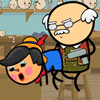Home » General Discussions » Heated Discussions and Debates » H1N1 Deuxième Partie
| H1N1 Deuxième Partie [message #386862] |
Mon, 18 May 2009 15:31  |
 |
 cheesesoda
cheesesoda
Messages: 6507
Registered: March 2003
Location: Jackson, Michigan
Karma: 0
|
General (5 Stars) |

|
|
It didn't get us the first time, so now it's back for revenge! Everybody get scared again... THE SWINE FLU IS IN ANOTHER OUTBREAK AND ANOTHER (ie. one) PERSON DIED FROM IT. HOLY SHIT, IT'S OUT TO GET US ALL.
whoa.
|
|
|
|
|
|
|
|
| Re: H1N1 Deuxième Partie [message #386867 is a reply to message #386862] |
Mon, 18 May 2009 15:50   |
 |
 nikki6ixx
nikki6ixx
Messages: 2545
Registered: August 2007
Karma: 0
|
General (2 Stars) |
|
|
I think the reunion of Limp Bizkit is far more dangerous to humanity than this flu is.
Renegade:
| Aircraftkiller wrote on Fri, 10 January 2014 16:56 |
The only game where everyone competes to be an e-janitor.
|
|
|
|
|
|
|
| Re: H1N1 Deuxième Partie [message #386889 is a reply to message #386862] |
Mon, 18 May 2009 17:46   |
 _SSnipe_
_SSnipe_
Messages: 4121
Registered: May 2007
Location: Riverside Southern Califo...
Karma: 0
|
General (4 Stars) |
|
|
1972 Breakout
1976 U.S. outbreak
Main article: 1976 swine flu outbreak
On February 5, 1976, in the United States an army recruit at Fort Dix said he felt tired and weak. He died the next day and four of his fellow soldiers were later hospitalized. Two weeks after his death, health officials announced that the cause of death was a new strain of swine flu. The strain, a variant of H1N1, is known as A/New Jersey/1976 (H1N1). It was detected only from January 19 to February 9 and did not spread beyond Fort Dix.[27]
President Ford receives swine flu vaccination
This new strain appeared to be closely related to the strain involved in the 1918 flu pandemic. Moreover, the ensuing increased surveillance uncovered another strain in circulation in the U.S.: A/Victoria/75 (H3N2) spread simultaneously, also caused illness, and persisted until March.[27] Alarmed public-health officials decided action must be taken to head off another major pandemic, and urged President Gerald Ford that every person in the U.S. be vaccinated for the disease.[28]
The vaccination program was plagued by delays and public relations problems.[29] On October 1, 1976, the immunization program began and by October 11, approximately 40 million people, or about 24% of the population, had received swine flu immunizations. That same day, three senior citizens died soon after receiving their swine flu shots and there was a media outcry linking the deaths to the immunizations, despite the lack of positive proof. According to science writer Patrick Di Justo, however, by the time the truth was known — that the deaths were not proven to be related to the vaccine — it was too late. "The government had long feared mass panic about swine flu — now they feared mass panic about the swine flu vaccinations." This became a strong setback to the program.[30]
There were reports of Guillain-Barré syndrome, a paralyzing neuromuscular disorder, affecting some people who had received swine flu immunizations. This syndrome is a rare side-effect of modern influenza vaccines, with an incidence of about one case per million vaccinations.[31] As a result, Di Justo writes that "the public refused to trust a government-operated health program that killed old people and crippled young people." In total, less than 33% of the population had been immunized by the end of 1976. The National Influenza Immunization Program was effectively halted on Dec. 16.
Overall, there were about 500 cases of Guillain-Barré syndrome (GBS), resulting in death from severe pulmonary complications for 25 people, which, according to Dr. P. Haber, were probably caused by an immunopathological reaction to the 1976 vaccine. Other influenza vaccines have not been linked to GBS, though caution is advised for certain individuals, particularly those with a history of GBS.[32][33] Still, as observed by a participant in the immunization program, the vaccine killed more Americans than the disease did.[34]
1988 zoonosis Breakout
1988 zoonosis
In September 1988, a swine flu virus killed one woman and infected others. 32-year old Barbara Ann Wieners was eight months pregnant when she and her husband, Ed, became ill after visiting the hog barn at a county fair in Walworth County, Wisconsin. Barbara died eight days later, after developing pneumonia.[35] The only pathogen identified was an H1N1 strain of swine influenza virus.[36] Doctors were able to induce labor and deliver a healthy daughter before she died. Her husband recovered from his symptoms.
ILI was reportedly widespread among the pigs exhibited at the fair. 76% of 25 swine exhibitors aged 9 to 19 tested positive for antibody to SIV, but no serious illnesses were detected among this group. Additional studies suggested between one and three health care personnel who had contact with the patient developed mild influenza-like illnesses with antibody evidence of swine flu infection. However, there was no community outbreak.[37][38]
1998 Breakout
1998 US outbreak in swine
In 1998, swine flu was found in pigs in four U.S. states. Within a year, it had spread through pig populations across the United States. Scientists found that this virus had originated in pigs as a recombinant form of flu strains from birds and humans. This outbreak confirmed that pigs can serve as a crucible where novel influenza viruses emerge as a result of the reassortment of genes from different strains.[39][40][41]
2007 Philippine outbreak
On August 20, 2007 Department of Agriculture officers investigated the outbreak (epizootic) of swine flu in Nueva Ecija and Central Luzon, Philippines. The mortality rate is less than 10% for swine flu, unless there are complications like hog cholera. On July 27, 2007, the Philippine National Meat Inspection Service (NMIS) raised a hog cholera "red alert" warning over Metro Manila and 5 regions of Luzon after the disease spread to backyard pig farms in Bulacan and Pampanga, even if these tested negative for the swine flu virus.[42][43]
2009 Breakout
2009 outbreak in humans
Main article: 2009 swine flu outbreak
The 2009 flu outbreak is due to a new strain of subtype H1N1 not previously reported in pigs.[4] In late April, Margaret Chan, the World Health Organization's director-general, declared a "public health emergency of international concern" under the rules of the WHO's new International Health Regulations when the first cases of the H1N1 virus were reported in the United States. [44] [45] Following the outbreak, on May 2, 2009, it was reported in pigs at a farm in Alberta, Canada, with a link to the outbreak in Mexico. The pigs are suspected to have caught this new strain of virus from a farm worker who recently returned from Mexico, then showed symptoms of an influenza-like illness.[46] These are probable cases, pending confirmation by laboratory testing.
The new strain was initially described as apparent reassortment of at least four strains of influenza A virus subtype H1N1, including one strain endemic in humans, one endemic in birds, and two endemic in swine.[47] Subsequent analysis suggested it was a reassortment of just two strains, both found in swine.[3] Although initial reports identified the new strain as swine influenza (ie, a zoonosis originating in swine), its origin is unknown. Several countries took precautionary measures to reduce the chances for a global pandemic of the disease.[48]
|
|
|
|
|
|
|
|
| Re: H1N1 Deuxième Partie [message #386903 is a reply to message #386895] |
Mon, 18 May 2009 19:06   |
 |
Starbuzzz
Messages: 1637
Registered: June 2008
Karma: 0
|
General (1 Star) |
|
|
| cheesesoda wrote on Mon, 18 May 2009 20:07 |
Hooray for irrational fears brought on by the annoyingly idiotic media!
|
They are having a field day with the job losses as well.

|
|
|
|
|
|
|
|
|
|
|
|
Goto Forum:
Current Time: Thu Nov 20 21:11:36 MST 2025
Total time taken to generate the page: 0.01070 seconds
|










